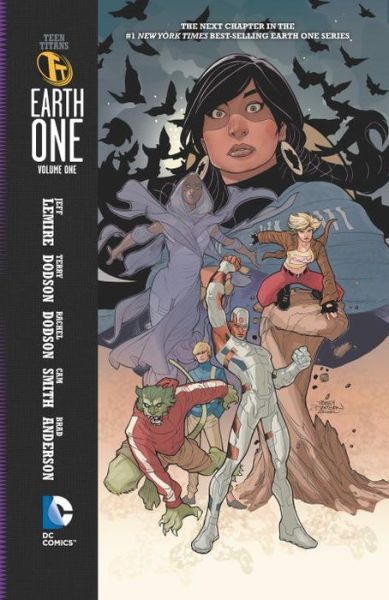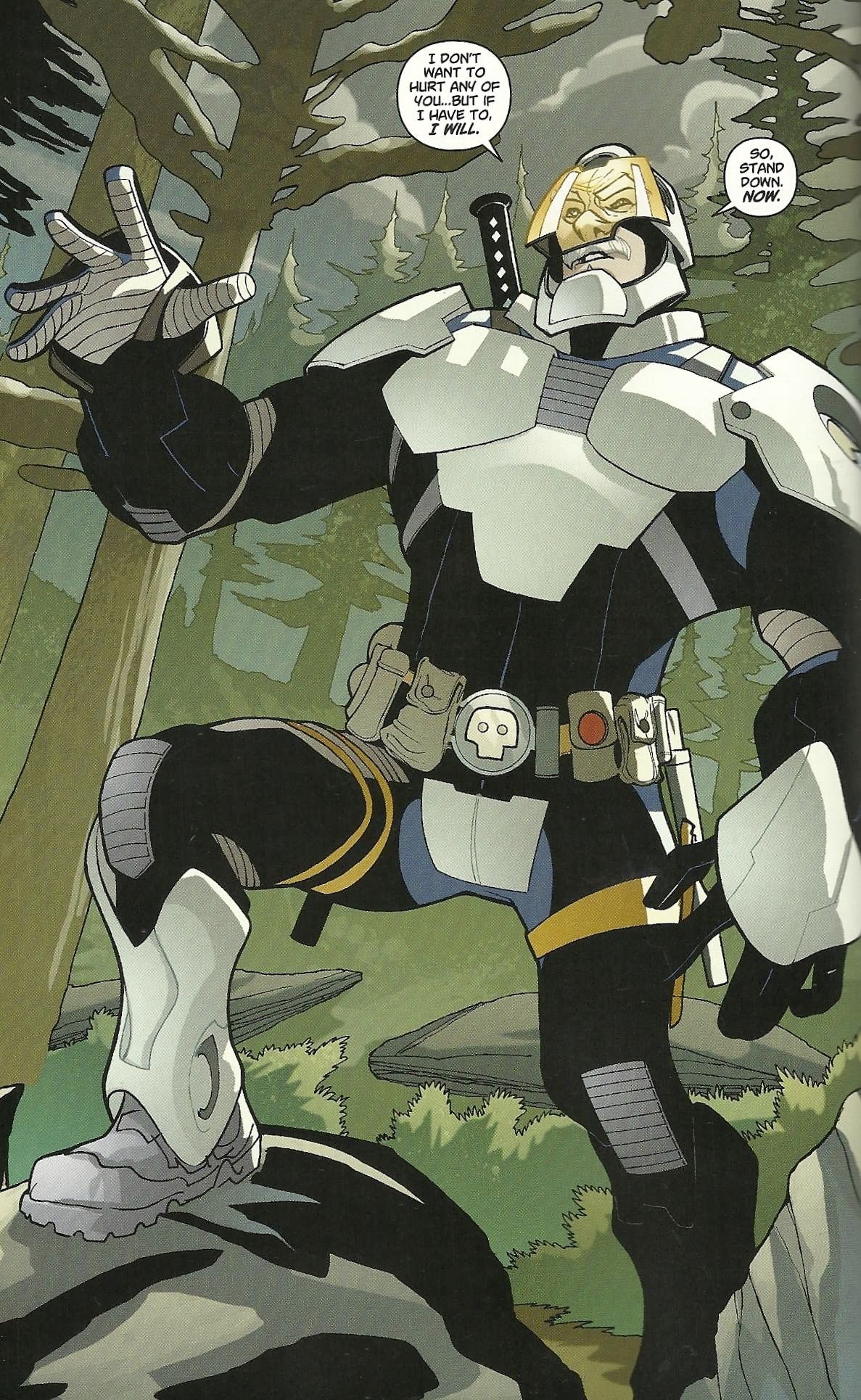The cover of Teen Titans: Earth One Volume One, as it's referred to on its title page, bears the all-caps blurb, "THE NEXT CHAPTER IN THE #1 NEW YORK TIMES BEST-SELLING EARTH ONE SERIES."
What exactly is "the Earth One series"? I'm a little confused. So too is its publisher.
The line of original graphic novels launched in 2010 with J. Michael Straczynski and Shane Davis' Superman: Earth One. The premise seemed to be the reintroduction of the character in a modern setting for a new audience. (Not unlike Marvel's millennial Ultimate imprint then, but in a more bookstore/library-friendly format.)
That was followed with a sequel and Batman: Earth One, by Geoff Johns and Gary Frank. Now the Teen Titans get a turn with this book by Jeff Lemire, Terry and Rachel Dodson and Cam Smith. Despite the blurb, the graphic novels aren't connected in any way other than design, format and, perhaps, intended audience.
The "Earth One" designation remains particularly perplexing, given the baggage the phrase is freighted with, its ever-changing meaning and the fact that these books are presumably targeted at readers who don't know or care about the oft-rebooted DC Multiverse's various parallel-Earth settings.
Now, in November 2014, the "Earth One" line is even more perplexing, and not just because DC is actively making its numbered Earths the focus of several publishing initiatives (The Multiversity, Earth 2: Worlds End/Futures End/Convergence).
The meaning of the phrase as used here is basically the same as "Ultimate" or "Elseworlds" or "All-Star," although its repurposed nature makes it a bit head-scratching. No, what's more perplexing about this book, which offers a new, continuity-free, modern version of the Teen Titans team for a wider audience, is that it sees release so relatively soon after 2011's Teen Titans #1, which, like the rest of DC Comics' New 52 reboot, was also meant to offer a new, continuity-free, modern version of the characters for a wider audience.
Which isn't to say this book is repetitive, of course. That series, initially written by Scott Lobdell and drawn by Brett Booth and Norm Rapmund, had an entirely different cast, for example. It's just strange to find a single publisher working on these parallel efforts all but simultaneously; Grant Morrison and company's first arc of the New 52 Action Comics and Scott Snyder, Greg Capullo and Danny Miki's "Zero Year" arc of Batman told the same basic stories as Superman: Earth One and Batman: Earth One, just in different formats.
It's difficult then to figure out what makes an "Earth One" comic different from a New 52 one, other than that they're published in a certain format, or have the words "Earth One" or "The New 52!" emblazoned on the cover. For example, Geoff Johns and Gary Frank's Shazam! Vol. 1 collection read exactly as a Shazam: Earth One might have, although it was originally parceled out within the pages of Justice League. In fact, the remit of Shazam! seems to have been exactly that of an Earth One book.
Some of this is just armchair comics publishing and marketing, of course, but the question is somewhat relevant from the perspective of a reader of DC's comics and a fan of the characters. The new, rebooted version of the Teen Titans that Lemire and the Dodsons came up with for their Earth One graphic novel is really good, fairly compelling, true to the original spirit of the characters involved (if not the original Teen Titans concept; this is based on the Marv Wolfman/George Perez team) and conceivably of interest to a wider audience than DC diehards.
Lemire uses the most basic of elements of the Wolfman/Perez era — Raven helping to gather young heroes, alien Starfire arriving on Earth — as a catalyst for a story involving super-powered teenagers coming together as a team. The cast is confined almost entirely to those created by Wolfman and Perez — Cyborg, Tara, Jericho and the aforementioned Raven and Starfire -- with the exception of Arnold Drake and Bob Brown's Garfield Logan (here codenamed Changeling), who, like Dick Grayson, Wally West and Donna Troy, was among the preexisting characters folded into Wolfman and Perez's Titans comics.
The characters are all rather closely related, which gives the book a perhaps claustrophobic feel — you'd only need about a half-dozen locations to shoot this as the TV pilot it reads so much like — but is also a more economical way to introduce and bind them together, and one denied Wolfman when he was writing his original version within the confines of a monthly comic.
Navajo 16-year-old shaman-in-training Raven has begun having strange dreams of a distressed alien family that apparently fell to Earth and found by mysterious, semi-sinister government types, all with names familiar to longtime DC readers (Slade, Markov, Dayton, Rita).
Meanwhile, in Monument, Oregon, we're introduced to a cast of four high school classmates: bad girl Tara Markov, her boyfriend Victor Stone, super-smart grade-skipper Garfield Logan and quiet, mysterious Joseph Wilson. We also meet their parents, who, with the exception of Gar's dad Steve, are single parents with whom the kids have strained to stressed relationships.
When they all begin manifesting powers of some kind simultaneously, and sharing visions of Raven and Starfire, they untangle their shared origin: Each was somehow gifted with a different power set thanks to experiments conducted on the still-captive Starfire, and each was assigned a guardian or two to act as parents. These characters, based on the names dropped, seem to be culled from Doom Patrol comics as much as Teen Titans comics.
While the core four share little in common, they quickly Breakfast Club up and storm the facility where Starfire is being held, and learn the Earth-shattering truth about themselves that will eventually lead them to becoming a superhero team or family unit.
Terry Dodson probably isn't the first artist I'd have thought of to illustrate a Teen Titans book like this, but he acquits himself nicely, and takes to the material in a way that seems to be an entirely new style, some of which may be the influence of inker Cam Smith, who joins Dodson's regular inker Rachel Dodson on finishing his art.
The character designs are all pretty top-notch, and interesting in the choices involved, with Dodson and company veering fairly far from the expected, but not so far that anything feels particularly wrong.
Raven is, as mentioned, a Native American character, and she looks it; she wears an all-black body suit and blue cape (neither of which seem all that natural for the weather of New Mexico), and earrings with rave shapes on them, although these are more in the style of Southwestern art rather than the stylized raven shapes of Perez's character.
Jericho and Tara never adopt a costume — no one does in the course of this volume — and their powers don't affect their appearance in anyway.
However, Gar's powers do, and he turns green. Rather than transforming into animals, he simply takes on aspects of them, looking like a were-cat or a were-rat at various points.
So too do Vic's powers affect his appearance. He's depicted as tall and lanky, rather than the bigger, more muscular character we've become accustomed to (particularly in the Teen Titans cartoons, where he dwarfs his teammates). And rather than having robot parts substituting human ones, he has a sort of liquid metal that gradually seeps out of his skin. Starfire, whose comic book costumes are famously barely there, is here completely wrapped up in a neck-to-toe white suit.
A water-breathing, fish-like "Tempest" also appears briefly, and the two-eyed Slade Wilson dons his Deathstroke get-up, which differs greatly from his costumes in all other media appearances (and he's got the build of a former football player).
More Titans will likely appear in future volumes, as Raven's grandfather shows her a wheel of symbols correlating to 10 other characters, only six of whom seem to appear in this book (there's a bolt of Flash-like lighting and a bat that seem easy enough to match up to characters, as well as a sword and a blue diamond, which I can't connect to any confidence to any characters, Titans or otherwise).
And there will be more volumes ... as long as this one sells OK, I suppose. It ends with a pretty dramatic cliffhanger, and all of the characters depicted on the cover have yet to gather in the same place at the same time, or, in the case of Cyborg, to appear completely costumed. There's also the matter of all the unresolved issues regarding their origins, and the names of other characters dropped, like a never-seen Caulder.
It's pretty promising, and the sort of Teen Titans comic I wouldn't mind reading on a monthly basis, rather than a once-a-year (or two or three) basis. So please don't let the murky marketing of the book, questionable editorial direction of DC's line, or existential questions about the Earth One publishing program scare you away.
What is Earth One? I'm not entirely sure, but, in the case of Teen Titans: Earth One at least, it's good comics.






